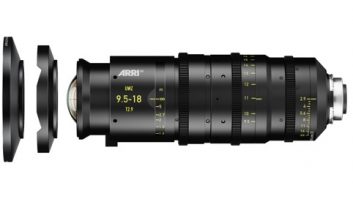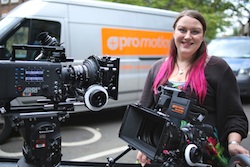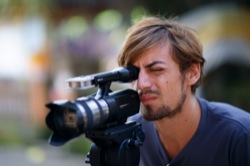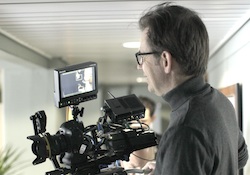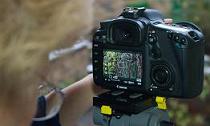
One of the most exciting developments of the past year, for those whose ambition is larger than their budget, has been the introduction of HD DSLR cameras that offer large sensors and a huge range of lenses for less than the price of a Sony EX1. DSLR development analysis by David Fox
It was notable that about half of all the cameras on show at the February Broadcast Video Expo in London were HD DSLRs – the previous year there had only been one (on the Canon stand). Low-budget filmmakers were the first to realise the potential, but now programmes you might have heard of are using them.
In some cases, such as on 24, they are being used for effects plates, on FlashForward it is short sequences using tilt shift lenses, on Numbers, cutaways. Michael Mann is apparently using HD DSLRs to shoot Luck, a pilot for HBO, while the final episode in this season’s House has been shot on a Canon 5D Mark II. As detailed elsewhere, TV2 Norway is currently shooting a complete series on DSLRs.
At present, only Canon truly offers HD DSLRs (full 1080p at 24/25/30fps as well as 720p 50/60). Most others, from Nikon and Pentax, are 720p only. A key attraction of DSLRs is their large sensor size, which offers shallower depth of field and excellent low light capabilities. The smallest, APS-C, is about 23x15mm, some 5.5 times the area of a broadcast 2/3-inch sensor (and about ten times the area of a half-inch sensor used in the EX1).
The largest DSLR sensor (on the 5D Mark II) is full frame 35mm (36x24mm), giving almost twice the image area of a 4-perf Super 35mm movie frame (and about 2.5 times that of APS-C).
The rapid acceptance for video use ‘has come as a very pleasant surprise’ for Canon. It introduced video so that its professional photographers could shoot short clips as part of a stills image shoot. “With the growth of the internet as a means of distributing news, Canon could see a growing demand for a product that would enable photojournalists to take high quality video without the need to carry two products. Consequently, we see this as a different market to the one our camcorders are aimed at,” explains a Canon Europe spokesperson.
“I think the 5D and the whole family of cameras have been a real game changer in the motion picture industry this year,” says Rodney Charters, cinematographer on 24, which has used five Canon DSLRs on a car-mounted exoskeleton rig to shoot effects plates for driving sequences.
“We have shot all the plates this season for 24 on 5Ds and 1Ds, so now we’re moving it into principal photography, second unit, and very soon to the first unit,” adds Sam Nicholson, 24’s visual effects supervisor.
They are eager for Canon to develop the concept further, from adding cine lenses that offer metadata and autofocusing while shooting, to facial recognition tracking software for automatic focusing on, say, the principal character (something consumer cameras can now do).
“The Canon 5D MKII with its large capture area is a breakthrough in cinematography. Its large capture area is similar to Panavision’s 35mm Anamorphic system and a little under 70mm, but by being able to use spherical lenses that are over a stop faster, it is capable of producing shallow focus pictures that have not been seen in motion pictures before,” says Graeme Beck, an Australian cinematographer who has created the Hyper 35, a camcorder mash-up that attaches a 5D to a Sony Betacam body, to give users all the familiar video controls (including peaking) in a shoulder-mounted package that is half the weight of a Betacam.
He is just about to start shooting a feature film with the system. “I did some tests on the big screen and was blown away by the results. We projected it alongside the Red and I couldn’t see any difference. Although the Red is cleaner in noise while comparing the pictures on a monitor, the 5D has more ‘life’ similar to the random grain of film,” he says.”I find going back to smaller format cameras annoying as they are just too flat. Its low light capabilities leave any camera for dead. It is a clear three stops faster than any camera I’ve used. As a cameraman for the last 30 years I’ve just about used every camera made and this camera literally sees in the dark.” Overcoming limitationsOther than fitting your DSLR to a Betacam body, there are further compromises to be made. “These cameras are designed primarily for stills photography, so they don’t have the ergonomic layout you’d expect from a video camera, and there are limitations in what controls you can use while recording and in facilities, especially audio. The recording codecs are not really ideal, and there is no HD-SDI output to bypass that. But low-light performance is excellent, and any DSLR, HD or not, is perfect for stop-frame animation or time-lapse videos,” says Christina Fox, broadcast trainer, UrbanFox.TV.
“Of course using a still camera for video can offer disadvantages. As they are primarily still cameras the design is set up to support handling for this purpose and not video,” admits Canon. “Currently during video recording, a DSLR is unable to match the autofocus speed of a camcorder. But we are finding that for many people, the positives far outweigh the negatives, and people can live with these for the type of image that a DSLR can produce.”
“The CMOS sensors used on DSLRs (as with most low-end camcorders) exhibit rolling shutter artefacts,” adds Fox. “When the camera is panned any vertical lines in the picture will be skewed, while photographic flashes may only occupy part of the picture. This means you have to use slower panning speeds, or a Steadicam or shake reduction technology for hand-held shots, or fix it in post,” adds Fox.
There are also restrictions on the length of clips that can be recorded at one time (12 minutes, or 4GB, on the EOS 7D, for example), generally due to file format limitations. They also require memory cards that are fast enough that they will record all the way through without problems.
However, the range of lenses you can fit to a DSLR is a big attraction. “You can get an inexpensive tilt shift lens, like a Lensbaby [about £150] to give you a look you wouldn’t normally see with a video camera. There are also extreme wide-angle zooms, a vast choice of primes or macro lenses, and adaptors to allow you use Nikon, Pentax or older screw-fit lenses with the Canons, so you can use what you already have or pick up an old lens that can give you the look you want very cheaply. Even an expensive DSLR lens will probably be a quarter of the price of a similar video lens,” she says.
“However, it won’t be easy to focus. Most modern DSLR lenses are made for autofocusing, but autofocus doesn’t work well, if at all, on these cameras when you’re in movie mode. So, you have to manipulate a tiny focus ring that has very limited travel, which makes it hard to focus precisely.”
You can have your camera fitted with a PL-mount adapter to take cine lenses, but you’ll also probably need a viewfinder attachment, or loupe, (such as the Zacuto Z Finder) to fit over the LCD screen and magnify the image. Add in the follow focus system, and other grip, and the cost rises, but will still undercut any comparable camcorder. Not acceptableNot everyone is so enthusiastic. “I tested the 5D and was absolutely appalled,” says Alan Roberts, a specialist consultant who does a lot of camera testing for the BBC. His test “showed some very worrying aliasing patterns, both luma and coloured”, due to the way the Beyer pattern sensor is down sampled or interpolated for HD.
He wrote (http://thebrownings.name/WHP034/): “Aliasing of this strength is typical of the bi-cubic interpolation used in stills cameras and graphics converters, where the presence of aliases is much less of a problem because they don’t move.” […] ” Since motion-sensitive compressors such as MPEG-2 and MPEG-4 depend on the cleanliness of edges to measure motion, these aliases can cause the compressor to allot undue bit-rate to motion and/or result in excessive compression artefacts. Either way, pictures with aliasing at the levels seen here are not acceptable as HDTV. “Because of this, he reckons “it is not acceptable as a broadcast camera.”
However, Beck says: ” With Adobe Media for editing and transfers I don’t have any aliasing or moire problems and find it is similar to any other video camera I’ve used.”
Similarly, Fox hasn’t had problems with her 7D, but knows people who’ve used DSLRs and rejected them because the aliasing and moiré patterns looked so bad on their projects. “If you are shooting lots of fine detail, especially horizontal detail (like architecture), and it or you move, it will be noticeable. But, if you use your shallow depth of field and defocus the background, the aliasing isn’t evident.
“You probably wouldn’t choose these cameras to shoot documentaries or anything that needs to be edited very quickly (because of the need to transcode to something like ProRes422 for render-free editing), but if you know what you are doing, you can produce pictures that look wonderful.”
To integrate the DSLR into the editing workflow, Canon has developed a plug-in for Final Cut Pro that will convert EOS movie clips into the ProRes 422 codec at about twice the speed of Apple’s standard conversion. Users will also be able to add timecode, reel names and metadata to footage more quickly and easily.
www.canon-europe.com
www.dop.net.au (Beck)www.UrbanFox.tv
